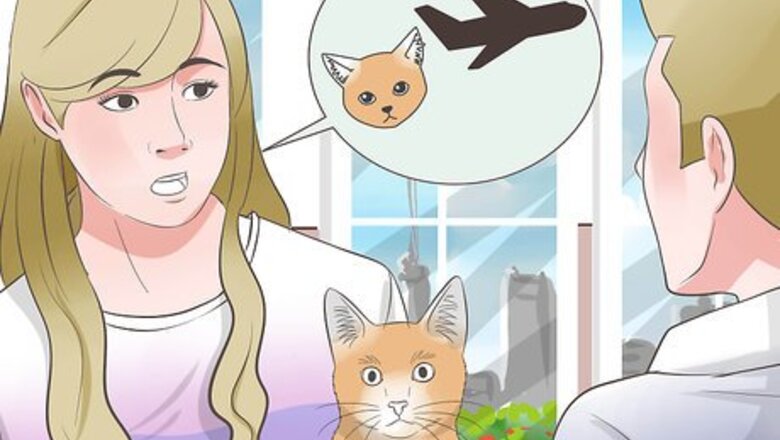
views
X
Trustworthy Source
The Humane Society of the United States
National organization devoted to the promotion of animal welfare
Go to source
But if you are moving to a new country and need to take your cat with you, you may have no choice but to transport him on a plane. There are many horror stories associated with transporting cats on an airplane[2]
X
Research source
, but with the right preparation, your feline friend can arrive to his new home safe and sound.
Transporting Your Cat in the Cabin

Talk to the airline about transporting your cat in the cabin. Contact the airline you are planning to fly with to check if you can transport your cat in the airport cabin in carrier under the seat in front of you. Avoid transporting your cat in the cargo or luggage hold if possible. Most airlines will allow you to take your cat on the plane in the cabin area for a small fee. Try to call the airline well in advance of your flight, as there is a limited number of animals allowed in the cabin during a flight.

Book your flight early. Some airlines restrict how many pets can travel in the cabin on a particular flight. Booking your flight early will ensure there is a spot for your cat. When choosing your seat, keep in mind you will not be able to sit in an exit row or against the bulkhead, as there must be a seat in front of you for the carrier.

Request the precise dimensions under the airline seat. The airline should be able to provide you with the exact dimensions of the space under the airline seat. This will dictate the size of your transport carrier for your cat.
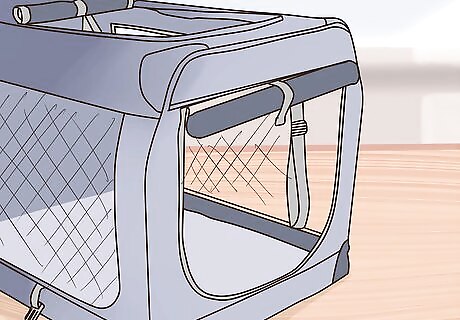
Check which types of carriers are allowed in the cabin. Most airlines will accept either hard-sided carriers or soft-sided carriers. Soft-sided travel carriers are easier to slide under the airline seat space. But only certain brands of soft-sided carriers are allowed by certain airlines. So check which types and brands are permitted in the cabin before you buy a carrier. A month before your trip, feed your cat in the carrier so he associates it with a positive activity. Play with your cat in the carrier and allow him to lounge or rest in the carrier. This will make it seem as welcoming as possible.
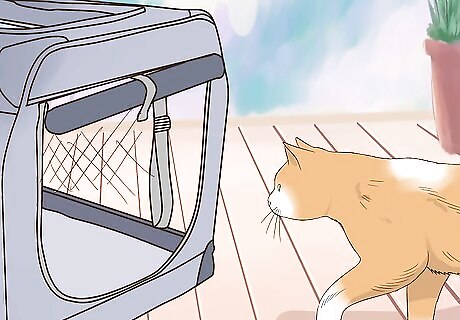
Have your cat practice entering and exiting the carrier. This will help him get more comfortable with the carrier and ensure it becomes part of his routine. Practicing getting in and out of the carrier will be good preparation for the security checks, when your cat will need to get in and out of the carrier on command.

Schedule a vet appointment close to the date of travel. You will need to ask your vet for vaccination records for your cat and a health certificate for travel. These documents are required by the airline to allow your cat to fly. Your vet should give you a health certificate that confirms your cat is in good health and free of parasites. All your cat’s vaccinations should also be up to date, including his Rabies vaccination. Your vet may also suggest implanting a microchip into your cat that will make it easier to locate him if he goes missing during travel. It acts as your pet's ID for life. Microchipping your pet is a simple procedure, where your vet injects a microchip the size of a grain of rice (12mm) under the surface of your pet's skin, between his shoulder blades. It does not hurt your pet and no anesthetic is required.
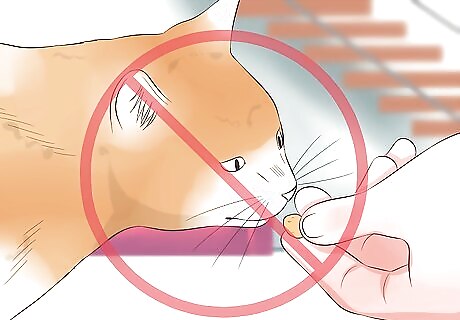
Don’t give your cat food on the day of travel. Traveling with a cat that has an empty stomach will limit the risk of nausea and vomiting. You can carry some of your cat’s food with you, in case he gets incredibly hungry on the flight. Don’t forget to also carry any medication your cat might be on in a clear plastic bag.
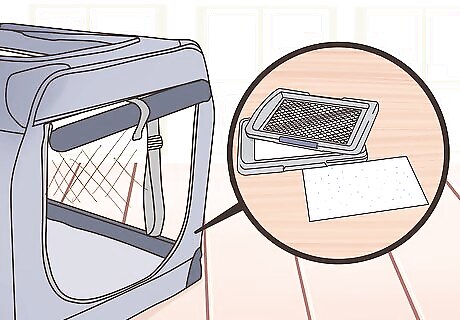
Line the carrier with absorbent “potty pads”. This will soak up any accidents by your cat during travel. Keep extra pads, a few zip lock bags, paper towels, and latex gloves for any necessary cleanup and containment of an accident.
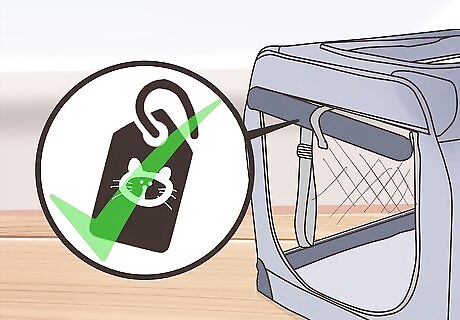
Put a luggage tag on your cat’s carrier. This will help to identify him in case the carrier gets lost in transit or in the airport. Put your name, permanent address, telephone number, and final destination on the tag.

Bring a cat harness for airport security. Your cat’s travel carrier must go through the luggage x-ray screening device at the airport, but your cat cannot. So you will need to attach a harness to your cat with a leash to prevent him from escaping. You should then carry your cat in your arms through the human screening device. Before you take your cat out of the carrier, prepare yourself and your belongings for screening. Remove your shoes, toiletries, and electronics and place them in bins to go through the x-ray machine. Remove your cat from the carrier, keeping him in the harness, and send the carrier through the machine. Carry the cat as you go through the human screening device. Then, find the carrier and safely place your cat inside before gathering your belongings.
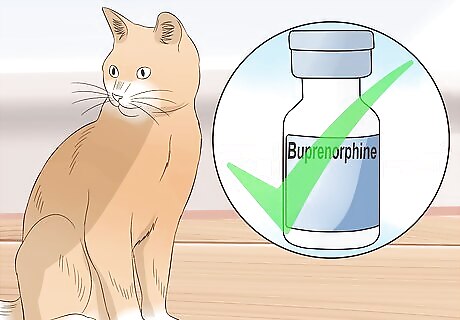
Give your cat a sedative if your vet prescribed one. Most cats can travel well without any medication. But some cats can experience tremendous stress during air travel. Talk to your vet if you are concerned about your cat’s anxiety levels when flying. Your vet might prescribe Buprenorphine, Gabapentin, or Alprazolam for your cat. Be sure to give your cat a dose at home before the flight as a “dry run” to make sure your cat does not react negatively to the medication.

Use a swaddle or pheromone wipes to lower your cat’s anxiety. If you want to avoid medicating your cat, you can try a Thundershirt, which swaddles your cat, much like swaddling an infant, to reduce anxiety. You can also use pheromone wipes or spray on the carrier before the flight to lower his anxiety levels. There are also pheromone calming collars available that you can buy to calm down your cat for the flight.
Transporting Your Cat in the Cargo Hold

Ask the airline for their companion animal incidents report. Though not ideal, some airlines may not allow animals in the cabin and if your cat is healthy, they can cope with air travel in the cargo hold. Most U.S. airlines are required to report all companion animal incidents that occur in the cargo hold. Look at the performance record of the airline you are planning to fly with. If possible, choose an airline with a low number of companion animal incidents in the cargo hold. Animals flown in the cargo area of airplanes are killed, injured, or lost on commercial flights each year. Excessively hot or cold temperatures in the cargo area, as well as poor ventilation and rough handling are often to blame for these incidents. However, many cargo holds are now pressurized and have a certain level of climate control. Talk to the airline about any safety features in the cargo hold that will make your cat's travel more comfortable.

Try to get a direct flight. This will cut down on the amount of security checks you and your cat will have to go through. It will also lower the delay time of getting your pet off the plane, especially if your pet is traveling in the cargo hold. Always travel on the same flight as your pet. You can confirm this by asking the airline if you can watch your pet being loaded into the cargo hold before getting on the flight. Look for early morning or late evening flights if you are traveling in the summer as this will be the cooler times of the day and make the cargo hold less hot and stuffy for your cat. Choose afternoon flights if you are traveling in the winter, as it will be less chilly in the cargo hold for your cat.

Attach a collar on your cat with your information. Look for a collar that can’t get caught in the carrier doors. Put your name, home address, telephone name, and final destination on the collar. You should also put a travel label on the carrier with the same information in the event the carrier, and your cat, get lost during travel.

Trim your cat’s nails before the flight. This will protect your cat’s nails from getting hooked in the carrier’s doors, holes, and other crevices in the cargo area.

Schedule a vet appointment close to the date of travel. You will need to ask your vet for vaccination records for your cat and a health certificate for travel. These documents are required by the airline to allow your cat to fly. Your vet should give you a health certificate that confirms your cat is in good health and free of parasites. All your cat’s vaccinations should also be up to date, including his Rabies vaccination. Your vet may also suggest implanting a microchip into your cat that will make it easier to locate him if he goes missing during travel. It acts as your pet's ID for life. Microchipping your pet is a simple procedure, where your vet injects a microchip the size of a grain of rice (12mm) under the surface of your pet's skin, between his shoulder blades. It does not hurt your pet and no anesthetic is required.
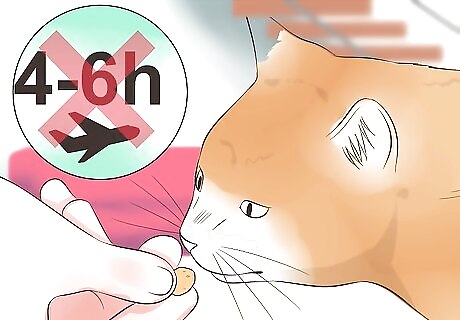
Do not feed your cat 4-6 hours before the trip. Traveling on an empty stomach will cut down on any nausea or vomiting. You can give your cat small amounts of water, or place ice cubes in the water dish in the carrier to keep your cat hydrated.

Carry a current photograph of your cat. If your cat is lost or misplaced during the flight or landing, the photograph will help airport security identify him.
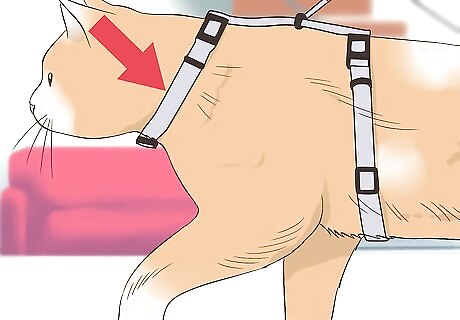
Bring a cat harness for airport security. Your cat’s travel carrier must go through the luggage x-ray screening device at the airport, but your cat cannot. So you will need to attach a harness to your cat with a leash to prevent him from escaping. You should then carry your cat in your arms through the human screening device. Before you take your cat out of the carrier, prepare yourself and your belongings for screening. Remove your shoes, toiletries, and electronics and place them in bins to go through the x-ray machine. Remove your cat from the carrier, keeping him in the harness, and send the carrier through the machine. Carry the cat as you go through the human screening device. Then, find the carrier and safely place your cat inside before gathering your belongings.

Notify the captain and at least one flight attendant that you have a pet in the cargo hold. Do this as you board the plane. The captain may take special precautions when flying, like avoiding turbulent areas while in the air.
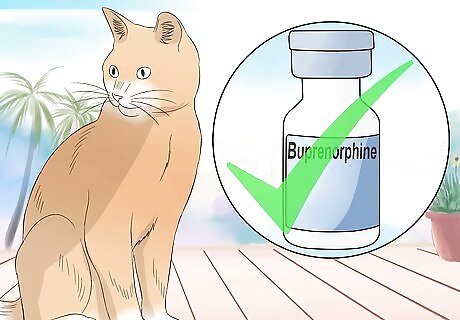
Give your cat a sedative if it is prescribed by your veterinarian. Your vet should give you medication for your cat that is specifically for air travel, such as Buprenorphine, Gabapentin, or Alprazolam. Be sure to give your cat a dose at home before the flight as a “dry run” to make sure your cat does not react negatively to the medication.

Open the carrier as soon as you get off the plane and examine your cat. If anything seems wrong with your cat, take him to a vet immediately. Get the results of the vet exam in writing, including the date and time, in the event you complain to the airline about the treatment of your cat in the cargo hold.



















Comments
0 comment